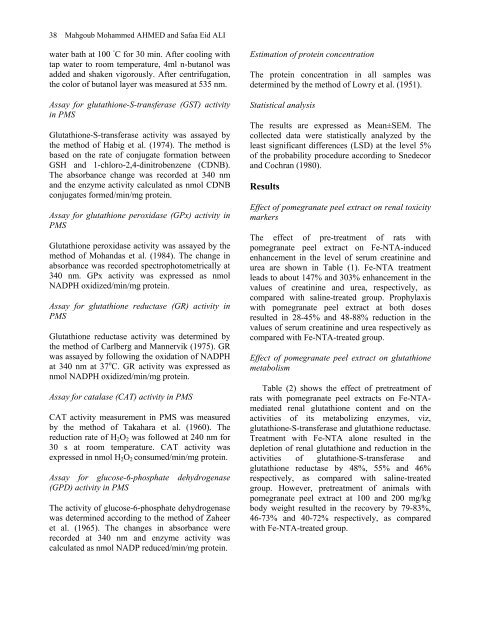Protective effect of pomegranate peel ethanol extract against ferric ...
Protective effect of pomegranate peel ethanol extract against ferric ...
Protective effect of pomegranate peel ethanol extract against ferric ...
Create successful ePaper yourself
Turn your PDF publications into a flip-book with our unique Google optimized e-Paper software.
38<br />
Mahgoub Mohammed AHMED and Safaa Eid ALI<br />
water bath at 100 ◦ C for 30 min. After cooling with<br />
tap water to room temperature, 4ml n-butanol was<br />
added and shaken vigorously. After centrifugation,<br />
the color <strong>of</strong> butanol layer was measured at 535 nm.<br />
Assay for glutathione-S-transferase (GST) activity<br />
in PMS<br />
Glutathione-S-transferase activity was assayed by<br />
the method <strong>of</strong> Habig et al. (1974). The method is<br />
based on the rate <strong>of</strong> conjugate formation between<br />
GSH and 1-chloro-2,4-dinitrobenzene (CDNB).<br />
The absorbance change was recorded at 340 nm<br />
and the enzyme activity calculated as nmol CDNB<br />
conjugates formed/min/mg protein.<br />
Assay for glutathione peroxidase (GPx) activity in<br />
PMS<br />
Glutathione peroxidase activity was assayed by the<br />
method <strong>of</strong> Mohandas et al. (1984). The change in<br />
absorbance was recorded spectrophotometrically at<br />
340 nm. GPx activity was expressed as nmol<br />
NADPH oxidized/min/mg protein.<br />
Assay for glutathione reductase (GR) activity in<br />
PMS<br />
Glutathione reductase activity was determined by<br />
the method <strong>of</strong> Carlberg and Mannervik (1975). GR<br />
was assayed by following the oxidation <strong>of</strong> NADPH<br />
at 340 nm at 37 o C. GR activity was expressed as<br />
nmol NADPH oxidized/min/mg protein.<br />
Assay for catalase (CAT) activity in PMS<br />
CAT activity measurement in PMS was measured<br />
by the method <strong>of</strong> Takahara et al. (1960). The<br />
reduction rate <strong>of</strong> H2O2 was followed at 240 nm for<br />
30 s at room temperature. CAT activity was<br />
expressed in nmol H2O2 consumed/min/mg protein.<br />
Assay for glucose-6-phosphate dehydrogenase<br />
(GPD) activity in PMS<br />
The activity <strong>of</strong> glucose-6-phosphate dehydrogenase<br />
was determined according to the method <strong>of</strong> Zaheer<br />
et al. (1965). The changes in absorbance were<br />
recorded at 340 nm and enzyme activity was<br />
calculated as nmol NADP reduced/min/mg protein.<br />
Estimation <strong>of</strong> protein concentration<br />
The protein concentration in all samples was<br />
determined by the method <strong>of</strong> Lowry et al. (1951).<br />
Statistical analysis<br />
The results are expressed as Mean±SEM. The<br />
collected data were statistically analyzed by the<br />
least significant differences (LSD) at the level 5%<br />
<strong>of</strong> the probability procedure according to Snedecor<br />
and Cochran (1980).<br />
Results<br />
Effect <strong>of</strong> <strong>pomegranate</strong> <strong>peel</strong> <strong>extract</strong> on renal toxicity<br />
markers<br />
The <strong>effect</strong> <strong>of</strong> pre-treatment <strong>of</strong> rats with<br />
<strong>pomegranate</strong> <strong>peel</strong> <strong>extract</strong> on Fe-NTA-induced<br />
enhancement in the level <strong>of</strong> serum creatinine and<br />
urea are shown in Table (1). Fe-NTA treatment<br />
leads to about 147% and 303% enhancement in the<br />
values <strong>of</strong> creatinine and urea, respectively, as<br />
compared with saline-treated group. Prophylaxis<br />
with <strong>pomegranate</strong> <strong>peel</strong> <strong>extract</strong> at both doses<br />
resulted in 28-45% and 48-88% reduction in the<br />
values <strong>of</strong> serum creatinine and urea respectively as<br />
compared with Fe-NTA-treated group.<br />
Effect <strong>of</strong> <strong>pomegranate</strong> <strong>peel</strong> <strong>extract</strong> on glutathione<br />
metabolism<br />
Table (2) shows the <strong>effect</strong> <strong>of</strong> pretreatment <strong>of</strong><br />
rats with <strong>pomegranate</strong> <strong>peel</strong> <strong>extract</strong>s on Fe-NTAmediated<br />
renal glutathione content and on the<br />
activities <strong>of</strong> its metabolizing enzymes, viz,<br />
glutathione-S-transferase and glutathione reductase.<br />
Treatment with Fe-NTA alone resulted in the<br />
depletion <strong>of</strong> renal glutathione and reduction in the<br />
activities <strong>of</strong> glutathione-S-transferase and<br />
glutathione reductase by 48%, 55% and 46%<br />
respectively, as compared with saline-treated<br />
group. However, pretreatment <strong>of</strong> animals with<br />
<strong>pomegranate</strong> <strong>peel</strong> <strong>extract</strong> at 100 and 200 mg/kg<br />
body weight resulted in the recovery by 79-83%,<br />
46-73% and 40-72% respectively, as compared<br />
with Fe-NTA-treated group.
















